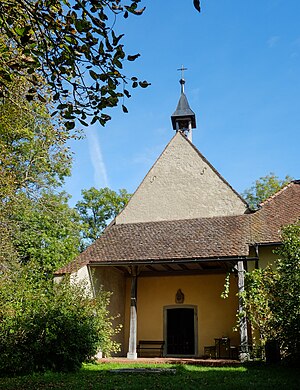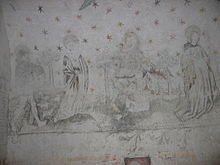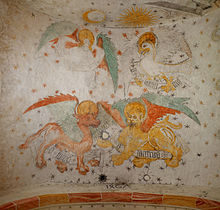Ramsberg Castle (Großschönach)
| Ramsberg Castle | ||
|---|---|---|
|
Ramsberg Castle - St. Wendelin Chapel |
||
| Alternative name (s): | Rammesperch, Ramesperg, Ramsperg | |
| Creation time : | around 1100 to 1200 | |
| Castle type : | Hill castle | |
| Conservation status: | Remnants in newer parts | |
| Standing position : | Count | |
| Place: | Heiligenberg -Katzensteig- "Ramsberg" | |
| Geographical location | 47 ° 51 '47.7 " N , 9 ° 14' 43.6" E | |
| Height: | 657 m above sea level NN | |
|
|
||
The castle Ramsberg than Rammesperch , Ramesperg and Ramsperg certified, is a former high medieval castle 750 meters east of Großschönach . The site lies in the district of Hattenweiler , a district of the municipality of Heiligenberg in the Lake Constance district in Baden-Württemberg , Germany .
Geographical location
The remains of Ramsberg Castle are around 657 meters above sea level in front of the plateau of a steep mountain hill, the so-called "Ramsberg". Today the densely forested Ramsberg lies between Pfullendorf and Überlingen near Großschönach in Upper Linzgau . The mountain is a terminal moraine from the Worm Ice Age .
On the former Ramsberger castle up is the interesting "pilgrimage chapel of St. Wendelin" with Romanesque and Gothic elements and choir frescoes of 1467. The chapel on the Ramsberg between Schonach, Neuhaus and Katzensteig , more precisely to the district of Hattenweiler , in the municipality of Heiligenberg in Lake Constance district , but is traditionally more closely associated with Großschönach.

From the cemetery Großschönach or a 15-minute loop trail leads through by ravines embossed young moraine landscape , up to the idyllic staufer temporal castle ruins with the inhabited "Klause St. Benedict." In 1908, citizens from Großschönach built a “ Lourdes Grotto ” in the “Ramsberger Tobel” (also known as “Buchenbanntobel”) , which attracts many believers to worship, especially in May.
history
A few fragments found already indicate an Iron Age settlement on the castle hill. The Ramsberg was used again when a castle was built by the Counts and Knights of Ramsberg. The St. Wendelin chapel and St. Benedict's hermitage form the further layers of the almost thousand-year history.
Count of Ramsberg
The history of the rule of the Ramsberg is closely linked to the history of Großschönach. Schönach is first mentioned in a document in 1092: Herimann Desonaicha appeared among the witnesses in a legal act by the Allerheiligen monastery in Schaffhausen for the village of Hemmental . In 1209 Schönach was counted among the estates that were alienated from the Weißenau monastery . In 1385 the parish church in Schönach received a letter of indulgence from the Bishop of Constance.
The Hohenstaufen hill castle of the Counts of Ramsberg and Pfullendorf was built in the 11th century by the Counts of Pfullendorf as a manorial seat. The Grafenhaus was a side branch of the once powerful Udalrichinger .
The Hinterstoffeln castle, located on the highest point of the northern summit of the Hohenstoffeln near Hilzingen- Binningen , belonged to the Ramsberg family . According to Hans-Wilhelm Heine, in 1067 it was owned by the Hegau Count Ludwig von Pfullendorf-Ramsberg zu Stoffeln .
The most important and last representative of the count dynasty, Rudolf II, called himself partly von Ramsberg , but from 1171 only von Pfullendorf , which could indicate that he had moved from Ramsberg to the newly built count's seat in Pfullendorf. With him, the male family died out in 1181. Ida, the heiress of the last count, is an ancestress of the House of Habsburg . The “Pfullendorfer Boar Seal” was Rudolf's personal seal and probably also a coat of arms. To his domain belonged: Stoffeln ( Hegau ), Ramsberg and Pfullendorf ( Linzgau ), Bregenz and Rheineck (Switzerland), u. a. the monastery bailiwick of St. Gallen and the umbrella bailiwick over the diocese of Chur .
After the count's departure, the Ramsberg was administered by ministerials who called themselves Lords of Ramsberg . Their coat of arms showed the "Ramm" (ram) on the "mountain". Later the castle rule was passed on to various servants as a fief, u. a. before the middle of the 14th century to Albrecht von Klingenberg , who received it as a fief from King Ludwig the Bavarian in 1347 and received the right to bequeath it to his daughters in the following year, which probably happened in the following years.
The Franciscan convent Hermannsberg, founded in 1360 and secularized in 1808 , which is now owned by the Lehenhof village community (belonging to Heiligenberg), was a gift from Messrs. Ramsberg in 1398.
According to Albrecht von Klingenberg, there were two servants who were each enfeoffed with half of the castle, one was Hans von Homburg and the other was Ulrich von Ems .
Überlingen Hospital
In 1409 Hans von Homburg sold half of Ramsberg Castle together with Großschönach to the Heilige Geist Spital in Überlingen , where Großschönach remained until Überlingen was mediatized in 1802/03. Ramsberg Castle experienced an eventful history in the following years. Most recently, several fiefdoms belonged , including a farm in Großschönach owned by Michael Schweizer and a farm in Kleinschönach, with which Georg III. was enfeoffed to. In June 1409, Hans von Homburg already sold a farm belonging to Ramsberg Castle in Schönach to the Herrmannsberg Klause 1.5 kilometers away . After the Überlinger Spital had acquired half of Ramsberg Castle from Hans von Homburg in 1409, it bought the other half from Ulrich von Ems in 1423. However, Ramsberg never appeared under the hospital's possessions, but always as the municipal bailiwick . The bailiff residing here managed, among others, Groß- and Kleinschönach, Hattenweiler, Furthof, Kirnbach, Katzensteig and Heiligenholz. Later the Ramsberg Bailiwick was merged with the Hohenbodman Bailiwick .
After the castle complex was transferred to the Überlingen hospital in the possession of the imperial city of Überlingen in 1409, the castle tower was cut off and given a roof. The examination of the roof beams resulted in a strike date in the year 1432. In 1467 the chapel consecrated to the Mother of God Maria was painted in the late Gothic style.
Most recently Anna von Hohenfels († 1617 in Waldmannshausen) was enfeoffed with the lordship of the castle.
The Imperial Castle and Bailiwick were looted during the Thirty Years War (1618 to 1648), the castle was destroyed and the chapel was probably also damaged.
The complex was rebuilt in the baroque period. The service room was given a baroque style. In 1720 the chapel was dedicated, redesigned and consecrated in honor of St. Wendelin .
Todays use
In 1900 the chapel became the property of the church and was restored in 1913/1914 and (1999) 2000/2001 through funding measures from the Baden-Württemberg Monument Foundation. The Förderverein Ramsberg - St. Wendelin eV tries to preserve it
The neighboring residential complex served as a forester's house until the beginning of the 20th century. Since 1993 there has been a hermitage dedicated to Saint Benedict in the house . The patron saint of the hermitage is the holy monk father Benedict of Nursia . The St. Benedict hermitage, the last remains of the castle of the Counts and Knights of Ramsberg from the 11th century, is inhabited by Brother Jakobus Kaffanke OSB , monk from the Beuron Monastery .
The castle has been looked after by the sponsorship of the Ramsberg - St. Wendelin Association and the St. Antonius parish since 1994.
archeology
An archaeological observation of the building in 1995 revealed fragments from the High Middle Ages to the late modern era, stove tiles and a piece of a bronze vessel, as well as three prehistoric fragments. A wall foundation could be observed in the inner courtyard. A lime kiln was located at the foot of the castle hill . In addition, the State Monuments Office has already carried out geomagnetic investigations on the plateau .
investment
Ramsberg Castle
Access to the former castle complex was from the northeast. Originally there was a gate with a trench in front of it . Following the presumed gate construction, the steep castle hill had to be circled until one could enter the actual facility on the castle plateau, which slopes down on all sides.
The castle complex, which can be described as small, with its pentagonal floor plan, was enclosed by a circular wall. You entered it from the northwest. The chapel is located here today on the remains of the former keep . The stump of the tower is one of the best preserved castle ruins. The castle courtyard was followed by the kennel on the west side . In the southwest corner of the complex is the possible location of the Palas . An outbuilding joins it in the east. There were possibly three more rooms on the northeast flank.
St. Benedict's hermitage
The residential / farmhouse visible today was built as the seat of the forest ranger on the remains of the eastern shield wall . It has housed the St. Benedict Hermitage since 1993. The hermitage is settled by a Benedictine monk from the St. Martin monastery in Beuron.
Benedict of Nursia (around 480-560) lived as a hermit (in Subiaco, 80 kilometers southeast of Rome) for a few years before he founded small communities and later the monastery on Monte Cassino. - The Klausner lives the spirituality of "pray and work". He prays several times his daily prayer times in the chapel.
The castle was once not only a political center, but also a spiritual one. This tradition, supported by the former castle chapel, which served as a pilgrimage church in the baroque era, is to be followed by the establishment of the hermitage of St. Benedict. The sponsor of the system is the Ramsberg - St. Wendelin eV association
St. Wendelin Chapel
Today there is a hermitage at the former castle site. The castle chapel probably dates from the Romanesque period. The structure of the chapel goes back to the high medieval castle complex (11th century) of the Counts of Ramsberg and Pfullendorf. It is the base of the keep , which, however, was at least twice as high. It is possible, but not certain, that there was already a chapel in this castle tower.
The painting of the choir room (pictures on the front side) was done on the dried plaster and the style is in the tradition of the late Gothic painting school of the Lake Constance area. The year in the triumphal arch dates the painting in the Ramsberg Chapel to 1467. The Marian motifs on the front side indicate a Marian patronage. The friezes of saints on the choir walls can only be partially clearly assigned today, further patrons are the saints Sebastian and Christopher (window opening) as well as Wendelin, Agnes, Florian and Agatha (left wall from left to right).
The late medieval frescoes of saints were probably attached by an unknown master hand after a castle fire and the subsequent enlargement of the castle chapel in 1467. This happened at the transfer to the Überlingen hospital. The hospital then opened the pilgrimage chapel to the public. With the passage to the Temple of Mary, the coronation of Our Lady as Queen of Heaven in the center of the painting, it can be said that the Ramsberg Chapel is an original Marian shrine. The iconological image program was discovered and uncovered in the course of repair work after an earthquake under a baroque starry sky in 1913. The similarity of this depiction to the one in the Mauritius rotunda in Constance is amazing. The four figures on the left side of the chancel in the middle and their attributes are clearly presented as the saints Wendelin, Florian, Agnes and Agatha. In the case of the painting on the right-hand side of the chapel, which was later destroyed by a window opening, one has to rely on guesswork. The historian Fredy Meyer from Stockach, a long-time friend and connoisseur of the Ramsberg, believes that the remains can also be used to locate a group of people, a representation of the Holy Family or perhaps even Saint Oswald. In the narrow central window, a face of Christ is placed in such a way that the believers gaze upon it during the conversion, as part of the ritual worship of the Eucharist, the veneration of Christ in the host. Christ is flanked by the then very popular Saints Sebastian and Christophorus. In popular piety, the latter was seen as a carrier and companion of the soul and thus as the ultimate guarantee for a “good death”. The dominant depiction of the sun and moon as a cosmic symbol that avoids disaster brings the master's leitmotif to light: The painted room as a picture of the heavenly cosmos, intended for a “salvific previous experience” of the pilgrim believer - of course with the profane goal of making this sound Implement coin. With the destruction of the Ramsberg in the Thirty Years' War, the Protestant Swedes would have put a brutal end to popular piety.
On the ceiling is the slogan "St Wendelin protect this house, also protect us & our belongings". Above the entrance door there is a modern relief with the inscription: “Lord you help both people and cattle how dear is your goodness, God, that human children trust under the shadow of your wings. They will be full of the rich goods of your home and you will water them with bliss like a stream. For with you is the source of life, and in your light we see the light ”( Ps 36 : 7-9 EU ).
The chapel on the Ramsberg is not only open to pilgrims on the Jakobsweg (route from Pfullendorf via Überlingen and Konstanz to the Schwabenweg in Switzerland), but can also be visited and inspected all year round. Guided tours are possible by prior arrangement.
Trivia
The Narrenverein Dreizipfelritter Großschönach eV has been referring to the former castle since 1960, so the syllable "Knight" is derived from the knights of Ramsberg and in 1995 the carnival figure "Burgschrat" was created based on a legend about the treasure at Ramsberg Castle. It speaks of a ghost that pulls sleepers by the hair at night and does all sorts of jokes. The name "Ramsberghalle" and "Ramsberggrundschule" Großschönach also reminds of the former castle complex.
literature
- Jakobus Kaffanke, Frieder Kammerer and Fredy Meyer (eds.): Old castle and place of silence. 1000 years of Ramsberg in Linzgau. Gmeiner, Meßkirch 2012 (Hegau Library 155) ISBN 978-3-8392-1333-9 .
- Arthur Hauptmann: Castles then and now - castles and castle ruins in southern Baden and neighboring areas . Verlag Südkurier, Konstanz 1984, ISBN 3-87799-040-1 , pp. 95-98.
- Wolfgang Krüger: The German castles and palaces in color. Castles, palaces, fortifications, manor houses and aristocratic palaces in the Federal Republic of Germany and Berlin (West) . Wolfgang Krüger Verlag / S, Fischer Verlag GmbH, Frankfurt am Main 1987, ISBN 3-8105-0228-6 .
- Alois Schneider: Castles and fortifications of the Middle Ages in the Lake Constance district . Find reports from Baden-Württemberg 14, 1989, No. 24, pp. 565-568.
- State Surveying Office Baden-Württemberg and State Foreign Traffic Association Baden-Württemberg (ed.): Palaces, castles, churches, monasteries in Baden-Württemberg . Stuttgart 1990.
- Karl Banghard: Construction-accompanying observations at Ramsberg Castle, Heiligenberg-Hattenweiler community . Platform 5/6, 1996/97, pp. 113-115.
- Michael Losse (ed.): Castles, palaces, aristocratic residences and fortifications on northern Lake Constance, Volume 1.1: Western part around Sipplingen, Überlingen, Heiligenberg and Salem . Michael Imhof Verlag, Petersberg 2012, ISBN 978-3-86568-191-1 , pp. 66-68.
- Fredy Meyer : Painted room as a heavenly cosmos. The late Gothic wall paintings in the St. Wendelinskapelle on the Ramsberg between Pfullendorf and Überlingen , in: Writings of the Association for the History of Lake Constance and its Surroundings , Issue 131 2013, ISBN 978-3-7995-1719-5 , pp. 51–81 (with numerous photos)
- Harald Derschka : Fund coins from the St. Wendelin chapel on the Ramsberg, Heiligenberg community, Lake Constance district . In: Writings of the Association for the History of Lake Constance and its Surroundings . 119. No. 2001, pp. 185-188. Digitized
Web links
- Reconstruction drawing by Wolfgang Braun
Individual evidence
- ^ Albverein. Tour leads to Ramsberg . In: Südkurier from October 15, 2008.
- ↑ Ralf Schrage: The castles of the Ramsberger . Lecture on July 16, 2011 at the conference 1000 years of Ramsberg history in Großschönach.
- ↑ Hans-Wilhelm Heine: Studies on weir systems between the young Danube and western Lake Constance . In: Landesdenkmalamt Baden-Württemberg (Hrsg.): Research and reports on the archeology of the Middle Ages in Baden-Württemberg. Volume 5 . Stuttgart 1978. ISSN 0178-3262
- ↑ Peter Schramm: The Counts of Ramsberg and Pfullendorf . Lecture on July 16, 2011, conference 1000 years of Ramsberg history in Großschönach.
- ↑ Falko Hahn (fah): The saints of the castle chapel. Historian Fredy Meyer gives a lecture at the Ramsberg conference. In: Südkurier of August 11, 2011.






